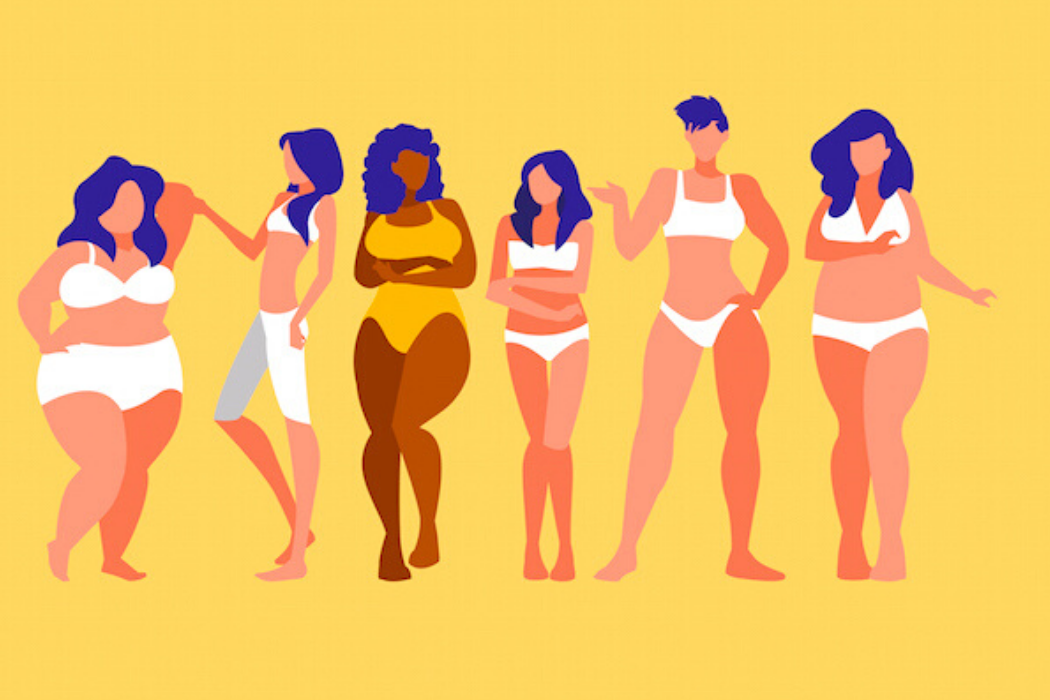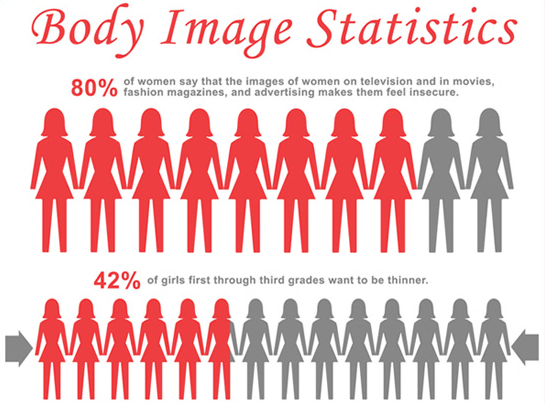Body Dysmorphia Caused By Social Media

What is Body Dysmorphia?
Body Dysmorphia is a disorder that creates a sense of worry or unsatisfied feelings about how one looks physically. A very little defect is seen to be terrible by the individual when others either don't notice it or do not find it a big deal. This disorder is found in most individuals, but many will not seek help because they are too ashamed or in denial. According to an article called Prevalence of BDD, 1.7% to 2.9% of the population suffers from body dysmorphia. That is equivalent to saying 5 million to 10 million people in the US are suffering from this disorder. The disorder itself is said to be an impairment to psychosocial functioning, develops a poor quality of life, and is a factor of high suicide rates.
Studies have proved that body dysmorphia exists in individuals from 5 years old being the youngest and 80 years old being the oldest. I am assuming this is because at five years old individuals start to feel self-cautious or notice differences between themselves and others. Researchers found a point prevalence of 2.5% of women vs 2.2% of men, and 1.9% of women and 1.4% of men experiencing body dysmorphia. It is women who are experiencing it slightly more, but it is a pretty equivalent percentage in both men and women. They also found that individuals experience body dysmorphia more commonly than OCD, anorexia nervosa, or schizophrenia. It is shocking because those are major disorders, so body dysmorphia really made its way to be up there to the most common disorders.
How it affects Self-Esteem?
According to the article Body Dysmorphic Disorder, "Approximately 40% of individuals with BDD actively think about the disliked body parts for 3 to 8 hours per day, and 25% report thinking about them for more than 8 hours per day. These preoccupations are almost always difficult to resist or control, and they are intrusive and associated with significant anxiety and distress." It is so unhealthy to spend extensive hours of your day thinking of your body parts you do not like. Individuals who experience body dysmorphia tend to have a bad self-esteem. All those individuals go through is putting themselves down and feeling less than others which is not right. They always feel as if they are not good enough whether they are too thin or too thick. It is almost like they will never be satisfied but their body type because they are hoping to look as expected by society.
There are compulsive behaviors that are caused by those obsessive thoughts about appearance that will help reduce their anxiety, but the behaviors will for the most part be harmful. The most common behavior in a person experiencing the disorder is comparing themselves to others in a negative way. Individuals will find any little flaw and bring themselves down. It can get pretty extreme and affects individuals lives way more than people who are not familiar with the disorder may think. People miss out on life opportunities like jobs for example because they have a fear of being judged by others or "not being good enough". It becomes a life barrier because a job is essential in one's life and not being able to take a job because of the disorder may affect your life negatively.
Why is it That Social Media Is a Factor?
The individuals who are constantly on social media are influenced by those they are looking at day to day. When looking at artists, influencers, or anyone on social media people gain ideas on what the ideal way of looking is which in reality doesn't exist. There is no set and stone to how an individual should look and that includes no body type, face structure, or style. Celebrities have molded an idea of how one should look, and they have truly influenced many individuals to try to be a copy and paste. The article mentioned that individuals will do excessive exercise, shopping constantly, or grooming themselves much more than needed. They are doing all this because they are being fed the idea of living a certain lifestyle to look like the people on social media look. People who experience body dysmorphia need to realize that many celebrities have gotten cosmetic surgeries to look the way they look. They also edit their photos from head to toe to resemble "perfection", which is not the case in real life. I found the photo I inserted below that says, "Don't wish to have a waist like her because she ain't having it too" referring to Kylie Jenner. It was captioned that because on the left you see a photo from her social media that is edited to make her body look super curvy, her face is practically flawless, and even the color of her outfit stands out way more. On the right she looks completely different because it is a screenshot of a video which was not edited.
Individuals should realize that social media makes everything look perfect because they get to choose what to post and let the world see. They will not post themselves looking "bad" because celebrities will always be in competition with each other to look better than one another and stand out more. It is literally their job which is why individuals should not be influenced by them whatsoever. You do not need to look like they do to be beautiful, handsome, or stylish. There is no right or wrong to body types which is what needs to be known when looking at social media. Individuals often feel like they need to follow footsteps which is what causes body dysmorphia. In the past years, I think social media has caused more cases of body dysmorphia within people for the same reason. In one of the studies they did eighty percent of the people who have been experiencing body dysmorphia have blamed it on television, fashion magazines, and advertisements. They added that it was the number one factor that made them feel insecure about themselves and how they look.

How Can we Make a Change?
Change can occur and should occur to bring more confidence to the individuals around us and lower the rates of individuals that experience body dysmorphia. All that is needed is more positivity and less judgment between ourselves to reduce those rates. Being thin is not what makes an individual beautiful and it needs to be addressed. Every commercial, movie, or advertisement always uses thin light complected models to play the role of the "pretty" or "main character" and that should change. The media needs to be more inclusive of any individual with any skin tone, height, weight, etc.. Being more inclusive in the media will make individuals feel more confident and bring reassurance to everyone no matter what they look like.
First of all, in order to make a change, we must bring awareness to the disorder. There should be more insight on what body dysmorphia is and why it is caused. That way everyone around people with the disorder can be more supportive of one another and reduce the rates. Cognitive behavior therapy is recommended to help patients with body dysmorphia and has shown improvements in individuals. What is known as the "Kardashian effect" mentioned in the article called Combating 'Social Dysmorphia' should be cancelled. No one should think they need to look like that or that their body is the expectation because they bought themselves into those bodies. Natural should be seen as equally beautiful and never looked down on. As mentioned in the article individuals need to set realistic expectations, recognize that beauty is ever-evolving meaning there is always different trends, and practicing self-love.

How it Affects me Personally?
This social issue affects me directly because I am an individual who is living through this new generation. This generation is full of fantasies you can say. It is sad to admit that no one can truly be themselves anymore. Not how they look, not how they act, not how they dress. Everyone kind of fell into a pattern of all wanting to look a certain way because social media says that is the perfect way a person should look or act. I stay true to myself and am natural on social media and in person, but I guess you can say I fall into the same patterns of others because they become styles. It is funny because I love the way I look but I look at social media and it makes me think I should try the looks they do or buy some clothes that the people on there are wearing. I do not experience body dysmorphia, but I see it more as fashion inspiration, I do not feel insecure about myself. I just do find myself doing things that I see online more often.
Not only am I affected but the people around me are too. A perfect example of this would be driving by a middle school, the little girls do not look little anymore. Social media has been influencing everyone to try to make themselves look a certain way and it is saddening. These past years I feel as if little kids did not have a childhood because they rushed to be grown. The media has really guided individuals to fit the social media expectations. They cover themselves with tons of makeup, wear baggy clothes because of insecurities, and overall try to be someone they are not.
I chose this issue because I don't think anyone should be a victim of body dysmorphia. Especially not if it is caused by factors like social media, other individuals' opinions, or simply the way others look. I mainly focused on body dysmorphia because many individuals focus on world disasters like poverty, addictions, and other disasters. I realized that sometimes people don't bring enough awareness to disorders like body dysmorphia because not a lot of people know what is even is. I asked around with my friends if they knew what body dysmorphia was and only some knew. I found myself explaining it to many of them and that's when I realized I was selecting a perfect topic to bring awareness on.
References
Bjornsson, A. S., Didie, E. R., & Phillips, K. A. (2010). Body dysmorphic disorder. Dialogues in clinical neuroscience. Retrieved November 10, 2021, from https://www.ncbi.nlm.nih.gov/pmc/articles/PMC3181960/.
Germany, J. (n.d.). Combating 'social media dysmorphia'. Rush System. Retrieved November 10, 2021, from https://www.rush.edu/news/combating-social-media-dysmorphia.
Prevalence of BDD. BDD. (n.d.). Retrieved November 10, 2021, from https://bdd.iocdf.org/professionals/prevalence/.
No comments:
Post a Comment